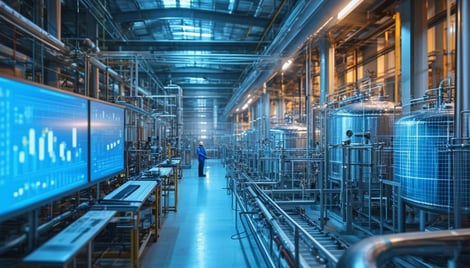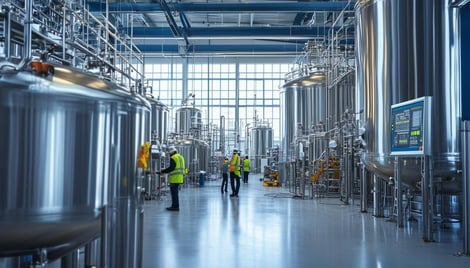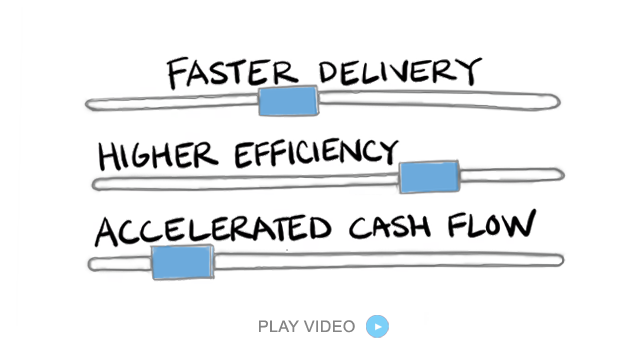Finding the Balance Between Structure and Flexibility in Chemical Manufacturing
Chemical manufacturing operates in a complex and highly regulated environment, where achieving operational efficiency without compromising quality and compliance is paramount. For Plant Managers, balancing the rigid structure required for consistent production with the flexibility to adapt to market shifts, raw material availability, and evolving customer demands can feel like navigating a tightrope.
Fortunately, advanced planning and scheduling tools like PlanetTogether, integrated with enterprise systems such as SAP, Oracle, Microsoft, Kinaxis, or Aveva, offer solutions to this perennial challenge.

The Dual Imperative: Structure and Flexibility
Structure in chemical manufacturing ensures consistency, safety, and compliance. Regulatory requirements dictate strict adherence to processes, and deviations can result in significant penalties or safety hazards. For instance, batch production of chemicals often requires precise adherence to formulations, equipment calibration, and production timelines.
On the other hand, flexibility enables responsiveness to changes, such as:
Fluctuations in raw material prices and availability.
Sudden shifts in customer demand.
Equipment downtime or maintenance needs.
Regulatory updates requiring changes in production processes.
The key to success lies in finding the right balance. Too much rigidity can lead to inefficiency and missed opportunities, while excessive flexibility risks operational chaos and non-compliance.
![]()

Leveraging Technology for Balanced Operations
Technology plays a pivotal role in achieving the ideal equilibrium between structure and flexibility. Advanced software solutions like PlanetTogether, when integrated with ERP systems such as SAP or Oracle, provide a robust framework for managing production planning and scheduling while enabling dynamic adjustments.
Enhanced Production Planning with PlanetTogether
PlanetTogether’s advanced planning and scheduling (APS) software streamlines production by:
Synchronizing schedules: Ensuring that every aspect of production—from raw material procurement to final packaging—aligns with demand forecasts.
Prioritizing tasks: Using algorithms to determine the most efficient production sequence while considering constraints like equipment availability and labor resources.
Monitoring performance: Providing real-time insights into production efficiency and identifying bottlenecks.
For a chemical manufacturing facility, where processes are often highly interdependent, these capabilities help maintain structure while allowing for adjustments when necessary.
Integration with Enterprise Systems
Integrating PlanetTogether with platforms like SAP, Oracle, or Kinaxis enhances its effectiveness. These systems manage vast amounts of data related to inventory, procurement, and financials. Integration creates a seamless flow of information, enabling:
Data-driven decisions: Real-time data from ERP systems informs production planning, helping Plant Managers adapt schedules to changes in raw material availability or customer orders.
End-to-end visibility: A unified platform provides a holistic view of operations, breaking down silos between departments.
Proactive risk management: Integrated systems can flag potential issues, such as supply chain disruptions or compliance risks, before they escalate.

Practical Applications in Chemical Manufacturing
Let’s explore how the balance between structure and flexibility manifests in key areas of a chemical manufacturing facility:
Managing Raw Material Variability
Raw materials in chemical manufacturing often have variable quality, lead times, and costs. With integrated tools like PlanetTogether and SAP:
Structured inventory management ensures critical materials are always available without overstocking.
Dynamic scheduling allows for quick adjustments when supply chain disruptions occur, reallocating resources to maintain production continuity.
Adapting to Market Demands
Market demands can shift rapidly, especially for specialty chemicals or consumer-driven products. Flexibility in production is critical to seize opportunities or mitigate risks. Integration enables:
Scenario planning: Tools like Kinaxis combined with PlanetTogether allow Plant Managers to simulate various production scenarios, assessing impacts before making changes.
Agile manufacturing: Quickly switching production lines or adjusting batch sizes to meet changing demand.
Ensuring Compliance Amid Change
Regulatory compliance is non-negotiable in chemical manufacturing. While structure ensures adherence to standards, flexibility is necessary to implement updates. With systems like Oracle and Aveva:
Automated workflows help track and document compliance processes, reducing manual errors.
Change management tools ensure new regulations or customer specifications are incorporated seamlessly into production schedules.

Benefits of the Right Balance
Achieving the optimal balance between structure and flexibility yields several benefits for chemical manufacturing plants:
Improved Operational Efficiency
Structured processes reduce waste and inefficiencies, while flexibility ensures resources are utilized where they are needed most. Advanced planning tools enable just-in-time manufacturing, minimizing downtime and excess inventory.
Enhanced Customer Satisfaction
Adaptability allows manufacturers to meet customer needs more effectively, delivering products on time even in the face of disruptions. Integrated systems ensure better communication and alignment across departments.
Increased Profitability
Balancing structure with flexibility reduces operational costs and maximizes throughput. By minimizing downtime and waste, manufacturers can improve their bottom line.

The Role of Integration in the Future of Chemical Manufacturing
As the chemical manufacturing industry evolves, the need for systems that combine structured processes with dynamic capabilities will only grow. Integration between tools like PlanetTogether and enterprise platforms such as SAP, Oracle, Microsoft, Kinaxis, or Aveva represents a critical step in this evolution.
These integrations enable Plant Managers to:
Respond proactively to challenges rather than reacting after the fact.
Align production processes with broader business objectives, such as sustainability or digital transformation goals.
Build a resilient operation capable of thriving in an unpredictable market.
Balancing structure and flexibility in chemical manufacturing is no longer an aspirational goal; it is a business imperative. With the right tools and strategies, Plant Managers can navigate this balance effectively, driving efficiency, compliance, and innovation in their facilities. Integration between PlanetTogether and leading enterprise systems provides the foundation for this success, ensuring that your plant remains competitive in an ever-changing industry landscape.
Are you ready to take your manufacturing operations to the next level? Contact us today to learn more about how PlanetTogether can help you achieve your goals and drive success in your industry.
Topics: PlanetTogether Software, Data-Driven Decisions, Integrating PlanetTogether, End-to-End Visibility, Proactive Risk Management, Chemical Manufacturing, Monitoring Performance, Synchronizing schedules, Prioritizing Tasks





















LEAVE A COMMENT